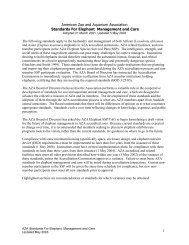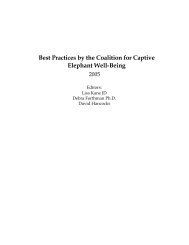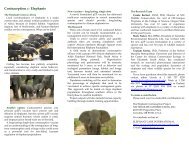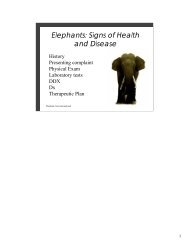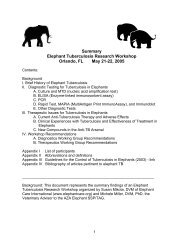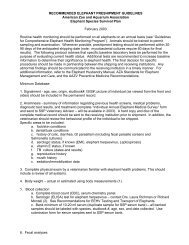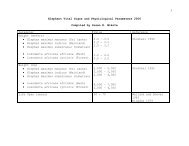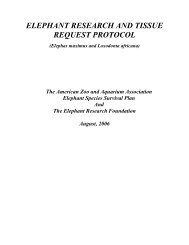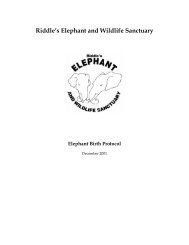Nepal Elephant TB Control and Mgt Action Plan.pdf - Elephant Care ...
Nepal Elephant TB Control and Mgt Action Plan.pdf - Elephant Care ...
Nepal Elephant TB Control and Mgt Action Plan.pdf - Elephant Care ...
- No tags were found...
Create successful ePaper yourself
Turn your PDF publications into a flip-book with our unique Google optimized e-Paper software.
<strong>Nepal</strong> <strong>Elephant</strong> Tuberculosis ulosis<strong>Control</strong> <strong>and</strong>Management agemen<strong>Action</strong> <strong>Plan</strong> (2011-2015)2015)authories <strong>and</strong> clinicians to devise acomprehensive plan to idenfy pockets ofinfecon <strong>and</strong> control or eradicate <strong>TB</strong> fromthe local environment.10. Human <strong>TB</strong> screeningHumans are a potenal source of <strong>TB</strong>for elephants. H<strong>and</strong>lers <strong>and</strong> other staffmembers working in close proximity toelephants will be <strong>TB</strong> tested annually. Newemployees will be tested before beginningwork. The <strong>TB</strong> posive staff members willnot be allowed to h<strong>and</strong>le or care for theelephants unl they have completed fourweeks of DOTS treatment. Medicaon will bestarted as soon as the person is diagnosed<strong>TB</strong> posive.11. Cap!ve elephant postmortem examina!onAll capve elephants that die will receive acomprehensive postmortem examinaonconducted by the <strong>TB</strong> <strong>Plan</strong> Veterinarian.<strong>Nepal</strong> elephant postmortem protocolworksheet is given in Appendix III.12. MonitoringThe feeding, working, <strong>and</strong> grazing of <strong>TB</strong>posive elephants will be closely monitoredby the owner <strong>and</strong> the <strong>TB</strong> <strong>Plan</strong> veterinaryofficer.13. Adop!on of animal welfare codeThe five freedom codes of animal welfarewill be always taken into consideraon. Thefive freedoms are:i. Freedom from hunger <strong>and</strong> thirstii.iii.Freedom from thermal <strong>and</strong> physicaldiscomfortFreedom from injury <strong>and</strong> diseaseiv.Freedom to express most normalpa$erns of behaviourv. Freedom from fear <strong>and</strong> distressIssue II: Risk of transmission of <strong>TB</strong> fromcap!ve to wild popula!on of elephants,rhino <strong>and</strong> other wildlife speciesStrategy: <strong>Control</strong> <strong>TB</strong> among capve elephants<strong>and</strong> instute pracces to prevent contactbetween capve <strong>TB</strong>-suspect or infected elephants<strong>and</strong> wildlife species.Program Ac!vi!es1. Segregate <strong>and</strong> treat infected elephantsAll infected elephants will be segregated <strong>and</strong>treated as per guidelines described underIssue I.2. Prevent contactAll possible measures will be applied toprevent the contact between capve <strong>TB</strong>suspector infected elephants <strong>and</strong> freeranging wildlife species. Use electric fencesor other praccal methods to preventcontact between capve <strong>TB</strong>-suspect orinfected elephants <strong>and</strong> free ranging wildelephants, rhinos <strong>and</strong> other large as well asmedium sized ungulates. Capve <strong>TB</strong>-suspector infected elephants will be restricted tospecified grazing areas. The segregaonplan should be approved by the <strong>TB</strong> <strong>Plan</strong>veterinary officer.3. Educate h<strong>and</strong>lersA regular <strong>TB</strong> control <strong>and</strong> managementeducaon program will be launched amongelephant h<strong>and</strong>lers, caretakers <strong>and</strong> theirfamily members. For this, a praccal guidehighlighng the causes of <strong>TB</strong>, symptoms,20




